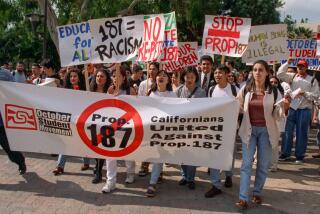U.S. Shouldn’t Have to Wait a Decade for a Fair Count : Census: The quality of life for nonwhite Americans is at stake in the pending decision on whether to adjust the ’90 tally.
- Share via
Within a month, Secretary of Commerce Robert A. Mosbacher will make the most important decision of his tenure. Mosbacher will decide either that the 1990 census will be adjusted to compensate for the undercount, or that the provisional census figures released earlier this year are to his satisfaction and will stand.
The most remarkable aspect of the secretary’s dilemma, which must be resolved by July 15, a court-imposed deadline, is that the future quality of life for nonwhite Americans is at stake.
Estimates of the undercount released last month by the Census Bureau show that while Latinos, African-Americans, Asians, Pacific Islanders and American Indians constitute roughly 25% of the U.S. population, they account for nearly 60% of the people excluded from the census. It is understandable that cities with large minority populations find themselves with an undercount rate higher than their state average and far above the national norm.
To adjust the count would give more than 3 million Americans of color opportunities often taken for granted, such as fair political representation and a fair share of public resources. Under an adjustment, for example, California and Arizona, states where more than a third of resident U.S. Latinos live, each would receive an additional seat in the House of Representatives, thus improving the opportunity to remedy the dramatic underrepresentation of Latinos in Congress.
To allow the provisional census figures to stand unadjusted would institutionalize a policy of racial and ethnic exclusion.
Causes of the undercount are varied. Among Latinos, some causes lie with the perception that the census is not confidential and safe, others with the manner in which the census itself is conducted. But in this census, awareness and desire to be counted were not issues for Latinos.
Latino organizations and media conducted an unprecedented educational outreach campaign to encourage Latinos to make themselves count. As a result, Latinos were the population group most knowledgeable about the census.
Ironically, one of the criteria that Mosbacher will weigh in reaching his decision is the effect it might have on future census efforts. For Latinos to be told today that they must endure the highest undercount rate of any population group, despite the Latino community’s own extraordinary efforts to avoid an undercount, would make it very difficult for the secretary of commerce nine years from now to encourage Latinos to do all they can to be counted, with no guarantee that the secretary will take the necessary steps to arrive at the most accurate count possible.
The shortcomings of the 1990 census in enumerating Latinos and other minorities will undoubtedly be studied and, one hopes, lead to meaningful reforms in the 2000 census. Another decade, however, is an unacceptable period to wait for a fair count.
The Census Bureau has already conceded that the 1990 census was the first in history not to improve upon its predecessor; indeed, the undercount rate is worse today than it was in 1980.
The bureau has also has established that the majority of people it missed were again people of color.
Finally, the bureau itself was preparing to adjust the 1990 census to compensate for the undercount up until October, 1987, when it was overruled by the Reagan Administration, precipitating the 1988 lawsuit that now forces the secretary of commerce to decide by July 15 whether to adjust the final figures.
An adjustment of the 1990 census would produce a more accurate portrait of what America was actually like on Census Day, April 1, 1990. It is the choice that Mosbacher must make.
More to Read
Get the L.A. Times Politics newsletter
Deeply reported insights into legislation, politics and policy from Sacramento, Washington and beyond. In your inbox twice per week.
You may occasionally receive promotional content from the Los Angeles Times.










